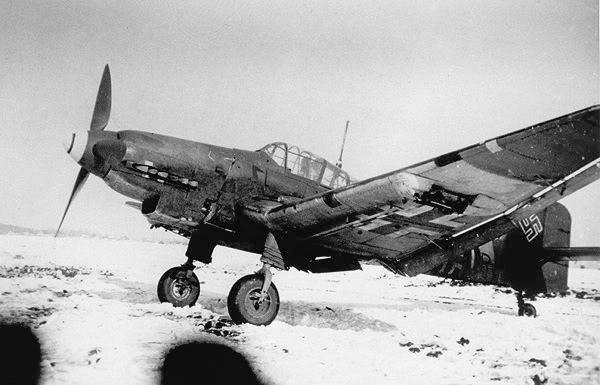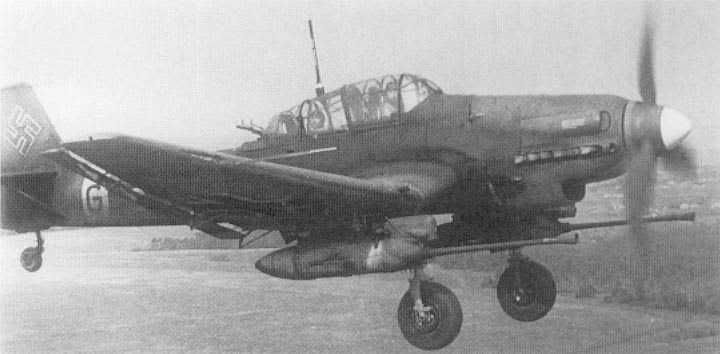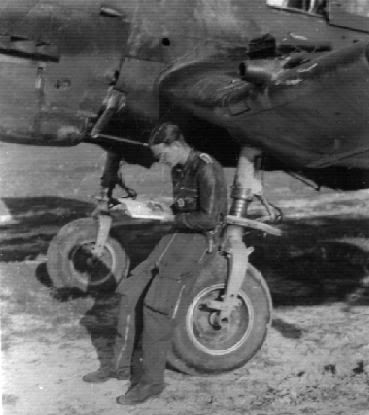Chicago Stuka - colo(u)rs
Tue Jan 22, 2008 10:44 pm
I'm trying to establish if the Ju 87R Stuka in the Museum of Science in Chicago has its original paint, or if it has been repainted at any point. It ended up in Chicago and was dropped by accident while cleaning, after which it went to the EAA at Hales Corner fort repair, and where it was displayed for a while before being returned and re-hung in Chicago.
I've e-mailed the museum, but not had a reply, or even a 'we are working on it' response. Poor.
The aircraft is significantly incomplete, with gashes in the fuselage underside as well as the missing spats, and I think the bombs are just mockups - again, if anyone knows any thing about it for certain, I'd appreciate the info.
Cheers,
I've e-mailed the museum, but not had a reply, or even a 'we are working on it' response. Poor.
The aircraft is significantly incomplete, with gashes in the fuselage underside as well as the missing spats, and I think the bombs are just mockups - again, if anyone knows any thing about it for certain, I'd appreciate the info.
Cheers,
Tue Jan 22, 2008 11:06 pm
I've been told the paint is almost all orignal (except maybe some touch-ups and repairs.) It certainly looks it..there are still shrapnel holes in the underside (don't know if it was damaged in flight or shot-up on the ground.) The upper colors are the standard RLM 79 sandy brown with RLM 80 olive blotches. The undersides are RLM 78 sky blue, but you can see the original (lighter and greener) RLM 65 light blue around the stenciling, which was masked off when the tropical colors were applied.
Here are some pics, shot in November of '06. Unfortunately, it's hanging up against the ceiling, making difficult to photograph and almost impossible to see the topsides.
SN



Here are some pics, shot in November of '06. Unfortunately, it's hanging up against the ceiling, making difficult to photograph and almost impossible to see the topsides.
SN



Re: Chicago Stuka - colo(u)rs
Wed Jan 23, 2008 12:42 am
JDK wrote:
The aircraft is significantly incomplete, with gashes in the fuselage underside as well as the missing spats, and I think the bombs are just mockups...
Hi James,
Please forgive my confusion, but for some reason I was under the impression that the Ju-87 operated in combat zones without spats on a regular basis.



I'm also unclear as to how gashes (holes, punctures, etc.) and other forms of damage render an aircraft as "incomplete" (unless you were thinking in terms of an incomplete restoration?).
Is there evidence of other major portions of the airframe or powerplant that are missing? To the uninformed and uneducated (like myself), it might appear that this survivor is actually quite complete.
TIA for any info you can supply.
Wed Jan 23, 2008 1:24 am
Dan
You are correct, many Luftwaffe aircraft operated without spats or wheel covers when conditions demanded (especially in Russia with snow and ice). This did happen in Africa, where this machine was captured, as well, because of the sand and some times mud.
James. When I did my Stuka Survivors for CW back in 2004 I was sent an early post war shot of the aircraft by Steve T. It showed the same camo as it currently wears. Also if you search the the LEMB there is a shot of it as found in the desert there somewhere!
The aircraft is often reported as a Ju-87B/Trop, in fact it is a Ju-87R-2/Trop. There are clear instructions under the wing about the fitting of drop tanks.
Dave
You are correct, many Luftwaffe aircraft operated without spats or wheel covers when conditions demanded (especially in Russia with snow and ice). This did happen in Africa, where this machine was captured, as well, because of the sand and some times mud.
James. When I did my Stuka Survivors for CW back in 2004 I was sent an early post war shot of the aircraft by Steve T. It showed the same camo as it currently wears. Also if you search the the LEMB there is a shot of it as found in the desert there somewhere!
The aircraft is often reported as a Ju-87B/Trop, in fact it is a Ju-87R-2/Trop. There are clear instructions under the wing about the fitting of drop tanks.
Dave
Wed Jan 23, 2008 1:44 am
Ah, the lessons of not being precise enough! I'm quite correctly pulled up. 
Firstly, thanks to Steve Nelson for the response and photos. It would be great if it is the original paint, and greater still if it could be confirmed. C'mon Chicago, it's an historic and ultra rare artefact - give us the gen.
I'd assumed that when operating without spats the Stukas retained the top part of the cover, rather than removing the lot, but Dan K's question and sourced photos show that not to be (always) true. That said, and I was aware of removing the lower part of the spat already, they usually seem to have retained some of the mounting (see in Dan's third photo, behind the crewman) and I'm sure they always retained the brakelines...
Significantly incomplete is perhaps unfair; no, Dan, I don't know what else (may) be missing, and I'm assuming (again, a risk) that the gun, crew uniforms and bombs (maybe racks) aren't original for that aircraft, but may be accurate or authentic. Can anyone confirm either way?
Thanks for the additional input to DaveM2.
Cheers
Firstly, thanks to Steve Nelson for the response and photos. It would be great if it is the original paint, and greater still if it could be confirmed. C'mon Chicago, it's an historic and ultra rare artefact - give us the gen.
I'd assumed that when operating without spats the Stukas retained the top part of the cover, rather than removing the lot, but Dan K's question and sourced photos show that not to be (always) true. That said, and I was aware of removing the lower part of the spat already, they usually seem to have retained some of the mounting (see in Dan's third photo, behind the crewman) and I'm sure they always retained the brakelines...
Significantly incomplete is perhaps unfair; no, Dan, I don't know what else (may) be missing, and I'm assuming (again, a risk) that the gun, crew uniforms and bombs (maybe racks) aren't original for that aircraft, but may be accurate or authentic. Can anyone confirm either way?
Thanks for the additional input to DaveM2.
Cheers
Wed Jan 23, 2008 2:27 am
Having looked at the bird fairly closely, the bombs look like mockups to me. The centerline rack also appears to be painted zinc chromate green, leading me to think its not original. The wheels are obviously American replacements (they look like they came from a Beech 18 to me.) The prop also looks pretty pristine and shiny. I know later Stukas used wooden props..don't know about the Ju-87R. If the original was wood, it may have deteriorated to the point that restoration or replacement were necessary.
It's great that the plane has been preserved, especially in such original condition, but it seems a bit out of place in a science museum. I would love to see it go to someplace like the NASM or NMUSAF, where it could be displayed better, and in context with its historical contemporaries.
SN
It's great that the plane has been preserved, especially in such original condition, but it seems a bit out of place in a science museum. I would love to see it go to someplace like the NASM or NMUSAF, where it could be displayed better, and in context with its historical contemporaries.
SN
Wed Jan 23, 2008 8:50 am
First Stuka (or Spitfire) I ever saw! There aren't many WW2 era warbirds on display in the Chicago area. Is it better to scatter them about or should they all be concentrated in one place? At least they aren't at the airport where you'd have to buy an airline ticket to ever see them.Steve Nelson wrote:It's great that the plane has been preserved, especially in such original condition, but it seems a bit out of place in a science museum. I would love to see it go to someplace like the NASM or NMUSAF, where it could be displayed better, and in context with its historical contemporaries.
Wed Jan 23, 2008 9:20 am
A machine of war that 30 years prior was nothing more than a glorified kite doesn't count as scientific? A machine heavier than air moving through the skies under it's own power isn't revolutionary science? 

I've lived here for 15 years, and I still haven't gotten into the right terminal to see the Wildcat at Ohare. But I nearly pee'd my pants when I saw the Dauntless at Midway.
I've lived here for 15 years, and I still haven't gotten into the right terminal to see the Wildcat at Ohare. But I nearly pee'd my pants when I saw the Dauntless at Midway.
Wed Jan 23, 2008 9:46 am
Well, I'd settle for her being better displayed, and maybe dusted once in a while. 
I managed to track down the F4F-3 at O'Hare a couple of years ago..unfortunately the pics are on a dead hard drive.
SN
I managed to track down the F4F-3 at O'Hare a couple of years ago..unfortunately the pics are on a dead hard drive.
SN
Wed Jan 23, 2008 3:49 pm
I thought the landing gear was off a T-6 and was replaced the last time it was taken down whenever that was. I also thought it was forced down when captured and the original gear was damaged. It's been hanging there a long time.
It would be nice to see it in front of the Spitfire
Steve
It would be nice to see it in front of the Spitfire
Steve
Wed Jan 23, 2008 10:52 pm
Certainly doesn't have T-6 gear now! When it was on display in Hales Corners I recall the original engine being on display next to it with a Flak hole in it.Steve wrote:I thought the landing gear was off a T-6 and was replaced the last time it was taken down whenever that was. I also thought it was forced down when captured and the original gear was damaged. It's been hanging there a long time.
Yup, here it is, although you can't see the hole...
http://www.airliners.net/open.file/0515863/L/
Thu Jan 24, 2008 7:09 am
Thanks again for the input, everyone. Certainly seems that the wheel hubs don't look right. Anyone able to id them as either authentic or of something else?
Thu Jan 24, 2008 9:00 am
We have talked about the Chicago Stuka before
http://warbirdinformationexchange.org/p ... highlight=
Steve
http://warbirdinformationexchange.org/p ... highlight=
Steve
Sat Jan 26, 2008 2:56 pm
I ran across this pic in an old book ("Junkers Ju-87 Stuka," Aero Publishers, c. 1966.) Looks to be the Chicago Stuka to me, as it was captured.
SN

SN

Sat Jan 26, 2008 5:59 pm
Hi James--
Email me, I'll send you a mid-40s shot of the Stuka taken (apparently) here in Canada. (I'd simply post it, but the file size of the scan is too large). Found the pic in an antique market in Cambridge, Ontario, about four or five years ago. Comparing it to pix I've taken of the Chicago Ju87R, the similarities are so striking that I can't believe the paint is anything but original 1942 Luftwaffe camo. (I'm also informed that the Spitfire Ia at Chicago wears circa-1944 paintwork applied when it was last overhauled in the UK).
The Stuka was rather bashed-about by the time it came to North America; the prop blades, for example, had all been "bobbed", and all the canopy glazing was missing, in the photo I have. Since then the wheels were replaced with Texan units. The spats were already absent by '45, and could indeed have been removed in service as Stuka spats sometimes were.
It'd be nice to see the Stuka (and the almost-equally-rare Spit Ia) parked rather than dangling from a ceiling; but my hat's off to the Chicago museum fathers of the late 40s for their foresight in taking on such airframes at a time few others would do so!
S.
Email me, I'll send you a mid-40s shot of the Stuka taken (apparently) here in Canada. (I'd simply post it, but the file size of the scan is too large). Found the pic in an antique market in Cambridge, Ontario, about four or five years ago. Comparing it to pix I've taken of the Chicago Ju87R, the similarities are so striking that I can't believe the paint is anything but original 1942 Luftwaffe camo. (I'm also informed that the Spitfire Ia at Chicago wears circa-1944 paintwork applied when it was last overhauled in the UK).
The Stuka was rather bashed-about by the time it came to North America; the prop blades, for example, had all been "bobbed", and all the canopy glazing was missing, in the photo I have. Since then the wheels were replaced with Texan units. The spats were already absent by '45, and could indeed have been removed in service as Stuka spats sometimes were.
It'd be nice to see the Stuka (and the almost-equally-rare Spit Ia) parked rather than dangling from a ceiling; but my hat's off to the Chicago museum fathers of the late 40s for their foresight in taking on such airframes at a time few others would do so!
S.